Input interpretation

H_2SO_4 (sulfuric acid) + NaHCO_3 (sodium bicarbonate) ⟶ H_2O (water) + CO_2 (carbon dioxide) + NaHSO_4 (sodium bisulfate)
Balanced equation
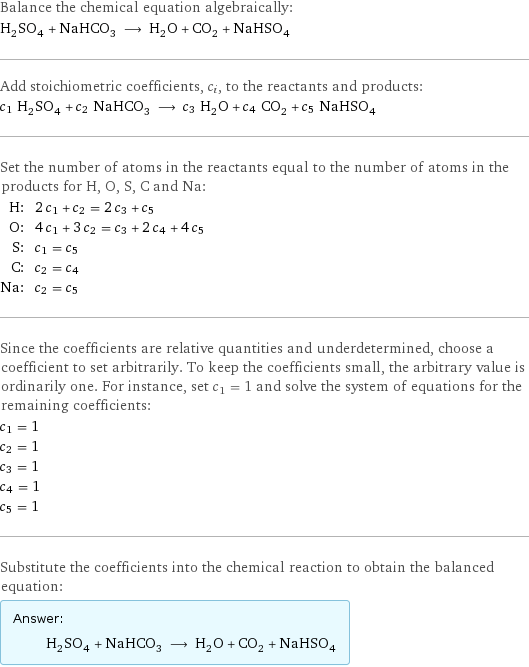
Balance the chemical equation algebraically: H_2SO_4 + NaHCO_3 ⟶ H_2O + CO_2 + NaHSO_4 Add stoichiometric coefficients, c_i, to the reactants and products: c_1 H_2SO_4 + c_2 NaHCO_3 ⟶ c_3 H_2O + c_4 CO_2 + c_5 NaHSO_4 Set the number of atoms in the reactants equal to the number of atoms in the products for H, O, S, C and Na: H: | 2 c_1 + c_2 = 2 c_3 + c_5 O: | 4 c_1 + 3 c_2 = c_3 + 2 c_4 + 4 c_5 S: | c_1 = c_5 C: | c_2 = c_4 Na: | c_2 = c_5 Since the coefficients are relative quantities and underdetermined, choose a coefficient to set arbitrarily. To keep the coefficients small, the arbitrary value is ordinarily one. For instance, set c_1 = 1 and solve the system of equations for the remaining coefficients: c_1 = 1 c_2 = 1 c_3 = 1 c_4 = 1 c_5 = 1 Substitute the coefficients into the chemical reaction to obtain the balanced equation: Answer: | | H_2SO_4 + NaHCO_3 ⟶ H_2O + CO_2 + NaHSO_4
Structures
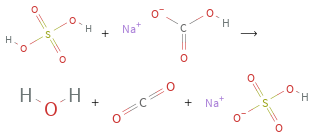
+ ⟶ + +
Names

sulfuric acid + sodium bicarbonate ⟶ water + carbon dioxide + sodium bisulfate
Reaction thermodynamics
Enthalpy
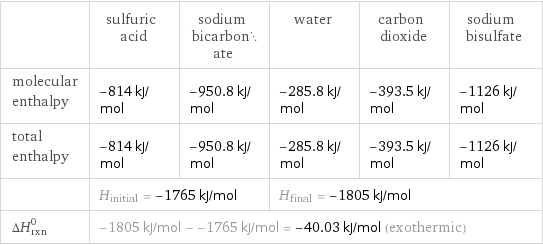
| sulfuric acid | sodium bicarbonate | water | carbon dioxide | sodium bisulfate molecular enthalpy | -814 kJ/mol | -950.8 kJ/mol | -285.8 kJ/mol | -393.5 kJ/mol | -1126 kJ/mol total enthalpy | -814 kJ/mol | -950.8 kJ/mol | -285.8 kJ/mol | -393.5 kJ/mol | -1126 kJ/mol | H_initial = -1765 kJ/mol | | H_final = -1805 kJ/mol | | ΔH_rxn^0 | -1805 kJ/mol - -1765 kJ/mol = -40.03 kJ/mol (exothermic) | | | |
Gibbs free energy
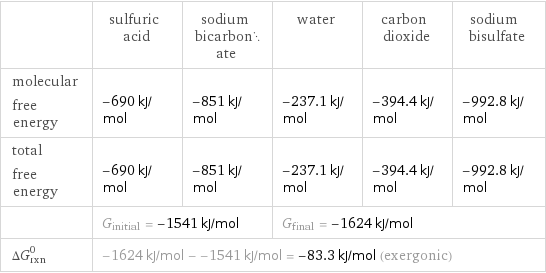
| sulfuric acid | sodium bicarbonate | water | carbon dioxide | sodium bisulfate molecular free energy | -690 kJ/mol | -851 kJ/mol | -237.1 kJ/mol | -394.4 kJ/mol | -992.8 kJ/mol total free energy | -690 kJ/mol | -851 kJ/mol | -237.1 kJ/mol | -394.4 kJ/mol | -992.8 kJ/mol | G_initial = -1541 kJ/mol | | G_final = -1624 kJ/mol | | ΔG_rxn^0 | -1624 kJ/mol - -1541 kJ/mol = -83.3 kJ/mol (exergonic) | | | |
Equilibrium constant
![Construct the equilibrium constant, K, expression for: H_2SO_4 + NaHCO_3 ⟶ H_2O + CO_2 + NaHSO_4 Plan: • Balance the chemical equation. • Determine the stoichiometric numbers. • Assemble the activity expression for each chemical species. • Use the activity expressions to build the equilibrium constant expression. Write the balanced chemical equation: H_2SO_4 + NaHCO_3 ⟶ H_2O + CO_2 + NaHSO_4 Assign stoichiometric numbers, ν_i, using the stoichiometric coefficients, c_i, from the balanced chemical equation in the following manner: ν_i = -c_i for reactants and ν_i = c_i for products: chemical species | c_i | ν_i H_2SO_4 | 1 | -1 NaHCO_3 | 1 | -1 H_2O | 1 | 1 CO_2 | 1 | 1 NaHSO_4 | 1 | 1 Assemble the activity expressions accounting for the state of matter and ν_i: chemical species | c_i | ν_i | activity expression H_2SO_4 | 1 | -1 | ([H2SO4])^(-1) NaHCO_3 | 1 | -1 | ([NaHCO3])^(-1) H_2O | 1 | 1 | [H2O] CO_2 | 1 | 1 | [CO2] NaHSO_4 | 1 | 1 | [NaHSO4] The equilibrium constant symbol in the concentration basis is: K_c Mulitply the activity expressions to arrive at the K_c expression: Answer: | | K_c = ([H2SO4])^(-1) ([NaHCO3])^(-1) [H2O] [CO2] [NaHSO4] = ([H2O] [CO2] [NaHSO4])/([H2SO4] [NaHCO3])](../image_source/28b3f45b37289c09b64635fa5075dac3.png)
Construct the equilibrium constant, K, expression for: H_2SO_4 + NaHCO_3 ⟶ H_2O + CO_2 + NaHSO_4 Plan: • Balance the chemical equation. • Determine the stoichiometric numbers. • Assemble the activity expression for each chemical species. • Use the activity expressions to build the equilibrium constant expression. Write the balanced chemical equation: H_2SO_4 + NaHCO_3 ⟶ H_2O + CO_2 + NaHSO_4 Assign stoichiometric numbers, ν_i, using the stoichiometric coefficients, c_i, from the balanced chemical equation in the following manner: ν_i = -c_i for reactants and ν_i = c_i for products: chemical species | c_i | ν_i H_2SO_4 | 1 | -1 NaHCO_3 | 1 | -1 H_2O | 1 | 1 CO_2 | 1 | 1 NaHSO_4 | 1 | 1 Assemble the activity expressions accounting for the state of matter and ν_i: chemical species | c_i | ν_i | activity expression H_2SO_4 | 1 | -1 | ([H2SO4])^(-1) NaHCO_3 | 1 | -1 | ([NaHCO3])^(-1) H_2O | 1 | 1 | [H2O] CO_2 | 1 | 1 | [CO2] NaHSO_4 | 1 | 1 | [NaHSO4] The equilibrium constant symbol in the concentration basis is: K_c Mulitply the activity expressions to arrive at the K_c expression: Answer: | | K_c = ([H2SO4])^(-1) ([NaHCO3])^(-1) [H2O] [CO2] [NaHSO4] = ([H2O] [CO2] [NaHSO4])/([H2SO4] [NaHCO3])
Rate of reaction
![Construct the rate of reaction expression for: H_2SO_4 + NaHCO_3 ⟶ H_2O + CO_2 + NaHSO_4 Plan: • Balance the chemical equation. • Determine the stoichiometric numbers. • Assemble the rate term for each chemical species. • Write the rate of reaction expression. Write the balanced chemical equation: H_2SO_4 + NaHCO_3 ⟶ H_2O + CO_2 + NaHSO_4 Assign stoichiometric numbers, ν_i, using the stoichiometric coefficients, c_i, from the balanced chemical equation in the following manner: ν_i = -c_i for reactants and ν_i = c_i for products: chemical species | c_i | ν_i H_2SO_4 | 1 | -1 NaHCO_3 | 1 | -1 H_2O | 1 | 1 CO_2 | 1 | 1 NaHSO_4 | 1 | 1 The rate term for each chemical species, B_i, is 1/ν_i(Δ[B_i])/(Δt) where [B_i] is the amount concentration and t is time: chemical species | c_i | ν_i | rate term H_2SO_4 | 1 | -1 | -(Δ[H2SO4])/(Δt) NaHCO_3 | 1 | -1 | -(Δ[NaHCO3])/(Δt) H_2O | 1 | 1 | (Δ[H2O])/(Δt) CO_2 | 1 | 1 | (Δ[CO2])/(Δt) NaHSO_4 | 1 | 1 | (Δ[NaHSO4])/(Δt) (for infinitesimal rate of change, replace Δ with d) Set the rate terms equal to each other to arrive at the rate expression: Answer: | | rate = -(Δ[H2SO4])/(Δt) = -(Δ[NaHCO3])/(Δt) = (Δ[H2O])/(Δt) = (Δ[CO2])/(Δt) = (Δ[NaHSO4])/(Δt) (assuming constant volume and no accumulation of intermediates or side products)](../image_source/357488f79f4dc0eaeaa50ec065f6bd1d.png)
Construct the rate of reaction expression for: H_2SO_4 + NaHCO_3 ⟶ H_2O + CO_2 + NaHSO_4 Plan: • Balance the chemical equation. • Determine the stoichiometric numbers. • Assemble the rate term for each chemical species. • Write the rate of reaction expression. Write the balanced chemical equation: H_2SO_4 + NaHCO_3 ⟶ H_2O + CO_2 + NaHSO_4 Assign stoichiometric numbers, ν_i, using the stoichiometric coefficients, c_i, from the balanced chemical equation in the following manner: ν_i = -c_i for reactants and ν_i = c_i for products: chemical species | c_i | ν_i H_2SO_4 | 1 | -1 NaHCO_3 | 1 | -1 H_2O | 1 | 1 CO_2 | 1 | 1 NaHSO_4 | 1 | 1 The rate term for each chemical species, B_i, is 1/ν_i(Δ[B_i])/(Δt) where [B_i] is the amount concentration and t is time: chemical species | c_i | ν_i | rate term H_2SO_4 | 1 | -1 | -(Δ[H2SO4])/(Δt) NaHCO_3 | 1 | -1 | -(Δ[NaHCO3])/(Δt) H_2O | 1 | 1 | (Δ[H2O])/(Δt) CO_2 | 1 | 1 | (Δ[CO2])/(Δt) NaHSO_4 | 1 | 1 | (Δ[NaHSO4])/(Δt) (for infinitesimal rate of change, replace Δ with d) Set the rate terms equal to each other to arrive at the rate expression: Answer: | | rate = -(Δ[H2SO4])/(Δt) = -(Δ[NaHCO3])/(Δt) = (Δ[H2O])/(Δt) = (Δ[CO2])/(Δt) = (Δ[NaHSO4])/(Δt) (assuming constant volume and no accumulation of intermediates or side products)
Chemical names and formulas
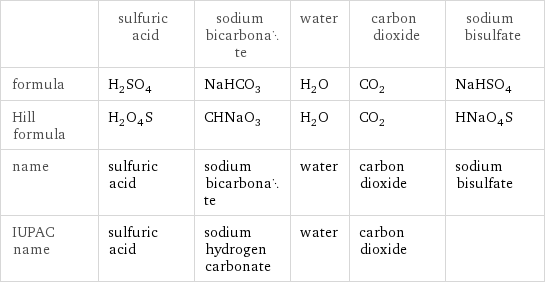
| sulfuric acid | sodium bicarbonate | water | carbon dioxide | sodium bisulfate formula | H_2SO_4 | NaHCO_3 | H_2O | CO_2 | NaHSO_4 Hill formula | H_2O_4S | CHNaO_3 | H_2O | CO_2 | HNaO_4S name | sulfuric acid | sodium bicarbonate | water | carbon dioxide | sodium bisulfate IUPAC name | sulfuric acid | sodium hydrogen carbonate | water | carbon dioxide |